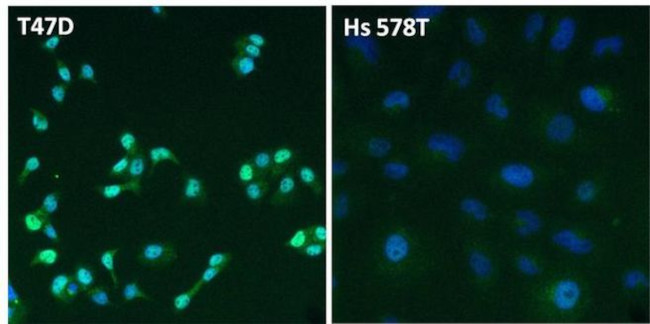Search Thermo Fisher Scientific
Invitrogen
Estrogen Receptor alpha Polyclonal Antibody
This Antibody was verified by Relative expression to ensure that the antibody binds to the antigen stated.
FIGURE: 1 / 10
Estrogen Receptor alpha Antibody (PA1-309) in ICC/IF

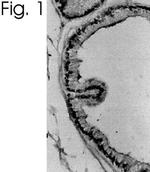

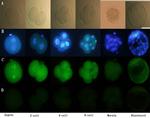

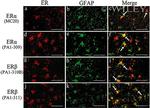
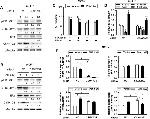
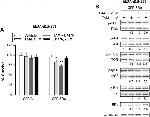
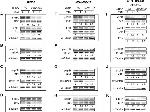

Product Details
PA1-309
Species Reactivity
Published species
Host/Isotype
Class
Type
Immunogen
Conjugate
Form
Concentration
Purification
Storage buffer
Contains
Storage conditions
Shipping conditions
RRID
Product Specific Information
PA1-309 detects estrogen receptor (ER) alpha from human, porcine and rat tissues and cells.
PA1-309 has been successfully used in Western blot, immunofluoresence and immunohistochemistry procedures. By Western blot, this antibody detects an ~64 kDa protein representing ER alpha from MCF-7 cell extracts. Immunohistochemical staining of ER alpha in rat prostate with PA1-309 results in primarily nuclear staining.
The PA1-309 immunogen is a synthetic peptide corresponding to residues N(21) E L E P L N R P Q L K(32) C of human ER alpha. This peptide sequence is completely conserved between human, rat, mouse, rabbit, sheep, porcine and bovine species. PA1-309 immunizing peptide (Cat. # PEP-037) is available for use in neutralization and control experiments.
Recombinant ER alpha expressed in baculovirus system (Cat. # RP-310) can be purchased for control experiments in Western blot and gel shift assays.
Target Information
Estrogen Receptors (ER) are members of the steroid/thyroid hormone receptor superfamily of nuclear receptors. The estrogen receptor is a ligand-activated transcription factor, that when bound to estrogen hormone, induces a conformational change that allows dimerization and binding to estrogen response elements (ERE) in DNA. When bound to EREs, ER can positively or negatively regulate gene transcription through the recruitment of coactivator or corepressor proteins. There are two different forms of the estrogen receptor, alpha and beta, encoded by separate genes (ESR1 and ESR2, respectively). Due to alternative RNA splicing, at least 4 estrogen receptor-alpha isoforms are known to exist (Isoform 1 (66 kDa), Isoform 2 (53 kDa), Isoform 3 (47 kDa), Isoform 4 (35 kDa)). Estrogen receptors are widely expressed in different tissue types and are essential for sexual development and reproductive function. They also play a role in other tissues such as bone. Estrogen receptors are involved in pathological processes including breast cancer, endometrial cancer, and osteoporosis.
For Research Use Only. Not for use in diagnostic procedures. Not for resale without express authorization.
Bioinformatics
Protein Aliases: DKFZp686N23123; ER; Er alpha; ER-alpha; ER36; esr 1; esr-1; Estradiol receptor; estrogen nuclear receptor alpha; Estrogen receptor; estrogen receptor 1 (alpha); estrogen receptor alpha; estrogen receptor alpha c-terminus splice variant 1-2; estrogen receptor alpha E1-E2-1-2; estrogen receptor alpha E1-N2-E2-1-2; estrogen receptor alpha splice variant, CTERP-1; estrogen receptor alpha splice variant, ERalphaDup5; estrogen receptor alpha splice variant, ERalphai45a; estrogen receptor alpha splice variant, ERalphai45bL; estrogen receptor alpha splice variant, ERalphai45bS; estrogen receptor alpha splice variant, ERalphai45c; estrogen receptor alpha splice variant, ERalphai56; estrogen receptor alpha splice variant, ERalphai67; estrogen receptor alpha variant delta 4; estrogen receptor protein; hER-alpha36; Nuclear receptor subfamily 3 group A member 1; RP1-130E4.1
Gene Aliases: ER; ER-alpha; Era; ESR; ESR1; ESRA; Estr; ESTRR; NR3A1; RNESTROR
UniProt ID: (Human) P03372, (Pig) Q29040, (Rat) P06211
Entrez Gene ID: (Human) 2099, (Pig) 397435, (Rat) 24890

Performance Guarantee
If an Invitrogen™ antibody doesn't perform as described on our website or datasheet,we'll replace the product at no cost to you, or provide you with a credit for a future purchase.*
Learn more
We're here to help
Get expert recommendations for common problems or connect directly with an on staff expert for technical assistance related to applications, equipment and general product use.
Contact tech support
